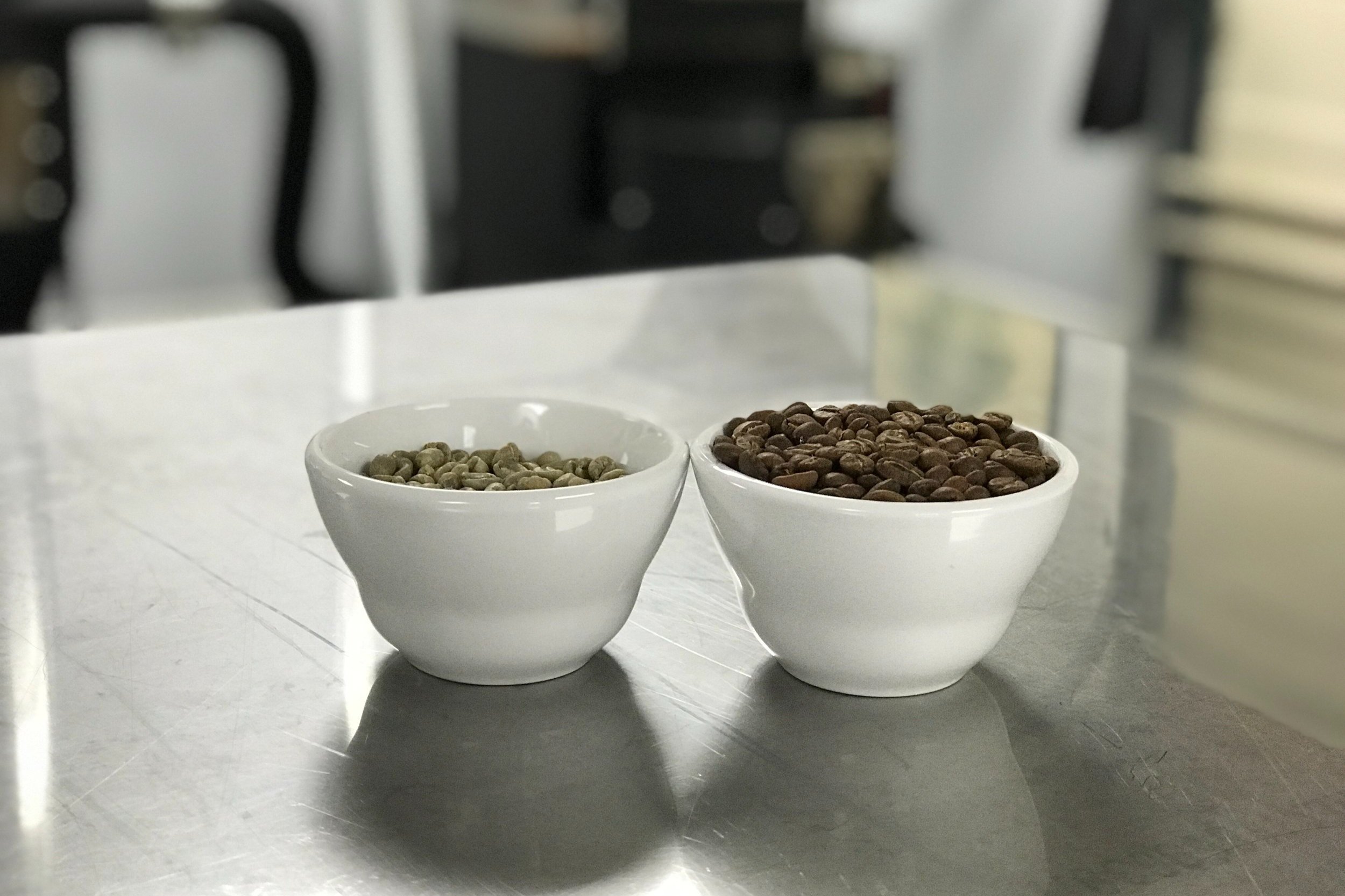Why take weight loss %
visualizing weight loss and volume gain from roasting. 100 grams of green vs 87.5 grams of roasted.
One important metric that can be taken during coffee roasting is loss, often referred to as weight loss percentage (from here on in the post I’ll refer to it as WL% or %WL). This metric is free and uses tools that coffee roasters already have on hand (bucket and a scale), yet it is not something that is universally taken and used in production settings. Most times, coffee roasters will use a pre-set WL% and just assume they know what their output is. However, differences in WL% can be telling in terms of production consistency, changes in green coffee, and roast level.
How does one calculate weight loss %
The calculations for weight loss are simple: (beginning weight - final weight)/beginning weight *100 (for a percentage output). Most data loggers will do the calculations for you! The big step that you may need encouragement to do is measure the final weight out of the roaster every single batch. This piece of data is important, and I would 100% encourage you to take and record it.
What is weight loss, and why does it matter?
Most of the weight lost during the roasting process is moisture content. Specialty coffee starts at 8-12% moisture content (though many people will indicate now that 11.5-12% is considered a little too high as it seems to be linked with increased water activity). On the other hand, roasted coffee tends to be < 3% moisture content. Assuming that the coffee starts at 10% moisture content, and as a light roast ends up with ~ 1% moisture content, then 9% of the overall weight loss could be ascribed to the loss of initial moisture. Where, though, does the rest come from?
In addition to the original moisture content of the coffee, water and water vapor are generated as byproducts of many of the reactions that happen during coffee roasting. Maillard reaction and sugar caramelization both produce water as a byproduct (for example). I can't know exactly how much water was created and then lost during the roasting process, but the majority of the weight lost is water, followed by carbon dioxide, and then everything else.
“According to Illy and Viani(1995) the roasting process can be roughly divided into a drying phase, a roasting phase, where a number of complex chemical reactions take place, and a final cooling phase. During roasting the beans loose weight. generally between14and20%,depending on the green bean quality, the process conditions and the target degree of roast (Clarke and Macrae, 1987). A major part of this weight loss is due to dehydration, whereas another substantial part (some 5 to 8 % for a medium degree of roast) is caused by a loss of dry matter, primarily as CO2. The chemical reactions that convert organic matter into gaseous products also result in the formation of a considerable amount of water that is then again lost as water vapor (Clarke and Macrae. 1987). Illy and Viani (1995) reported that 70 % of the degradation products are water and 30 % carbon dioxide. Dehydration is widely regarded as a steady process. However, Puhlmann and Meister (1989) claimed a development of water release in three stages. They found a first stage of slow dehydration below 100 °C, a stage of accelerated but migration-limited dehydration and a final stage of maximal dehydration rates due to microstructural changes of the bean.”
from:
Schenker, Stefan. “Investigations on the Hot Air Roasting of Coffee Beans.” Investigations on the hot air roasting of coffee beans - Research Collection. ETH Zürich, January 1, 1970. https://doi.org/10.3929/ethz-a-003889071.
Effectively, by measuring weight loss, a coffee roaster can learn a little about the progress of chemical reactions that have happened. While we may not know exactly how much of it was H2O, CO2, or other organic compounds, we will have a 1000-foot view of the extent of the chemical reactions. This is why weight loss percentage is a significant metric.
more below ↓
How can I use it practically when roasting?
There are a few different ways I find myself using WL% in my production roasting, and even in my experimentation. First of all, I use it to understand where I came out regarding the degree of roast I achieved with a particular coffee. Secondly, I use it to understand how consistent I am when production roasting. Finally, I use it to understand exactly how much coffee I need to roast to hit my production goals.
No. 1 Roast Degree
When talking about the degree of roast, it is important to note that the initial moisture content of the coffee will have a role in the final weight loss of the product. For example, if the Ethiopian coffee I am roasting is 10% moisture content, and yields a 12% weight loss, and I open a bag of the same coffee that is 9.5% moisture content (but all else is equal) I would expect an 11.5% weight loss percentage if I match roasts. These are just general guidelines, so also take them with a grain of salt.
<11 % Weight Loss:
When the coffee loses less than 11% weight loss, I am generally concerned that it is under-roasted / under-developed. Some lower moisture content coffees (green) can be in the 10’s, but I am generally skeptical of a roast when I am less than 11%.
11 - 13 % Weight Loss:
This is, almost without exception, light roast territory. Generally, unless the coffee is quite wet, as you move above 13% you end up with what I would consider a light-medium or medium roast.
14 - 16 % Weight Loss:
For me, this is medium roast territory. Here we tend to have less acidity and delicate notes and have more caramels, nuts, and chocolate.
17 - 18 % Weight Loss:
I would consider this a dark roast, though I recognize that people all have different perspectives on light, medium, dark, etc. So I can only tell you that for me this is a dark roast. Roast notes here become dominant. Smoke, dark chocolate, roast, and woody.
19 - 21 % Weight Loss:
This is extremely dark roasted for me. Roast notes dominate in what I would consider unpleasant ways.
>22% Weight Loss
If you’re not on fire, you’re getting pretty close. This is extremely dark roast territory and I would recommend avoidance.
Consider how roast WL% interacts with the roast profile. If you have a profile that you would consider to be a light roast and a weight loss percentage that is more suggestive of a medium or dark roast… there is likely something out-of-balance. Not to say “tradition” and say that you should always do something a certain way… I would just encourage you to consider the interplay of the two.
No. 2 Consistency
The second use of WL% is in consideration of your batch-to-batch consistency. If you have roasted the same coffee the same way then the weight loss % should also be the same. Generally speaking, if a roast is ≧ 0.5% different from the baseline, then something is seriously wrong. When doing my own QC over the years I have found that coffees out of spec ≧ 0.5% will also be out of spec regarding either the whole bean or ground color (or both). A simple check on your WL% can give you great peace of mind regarding your product and flavor consistency.
No. 3 Calculating coffee needs
Finally, we can use known weight loss measurements to calculate back so we know how much green we need to roast. Let’s talk about this through an example. Say that our best-selling coffee has a weight loss of 16%. We have a need, that day, of 156 units (KG or LBS… you pick) of roasted coffee. 156 units / (1-(16/100)) = 185.714 units of green coffee.
The math is: roasted needs / (1 - the weight loss % as a decimal) = green coffee needed to fulfill orders.
This would then need to be rounded up (for safety's sake) to 186 units. If your roaster was a 15-unit roaster (assuming you can do full capacity roasts instead of the assumed 80% loads) You would need to do 12.4 batches. Since you are only set up to operate at peak efficiency, you roast 13 batches. This lets you fulfill your orders and have 9 units leftover for emergency orders.
Conclusion
In closing, take your weights in and out of the roaster every single time. It will help you tremendously in understanding what is happening with your roast degree, consistency, and inventory management. In addition, if you ever have to call upon a consultant like myself for help or training, you will already have some of the data I am going to ask you for.
Thanks,
Rob



